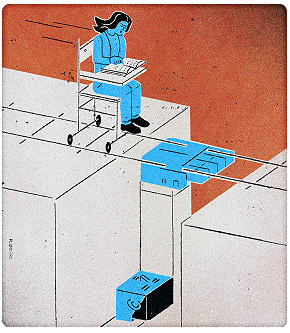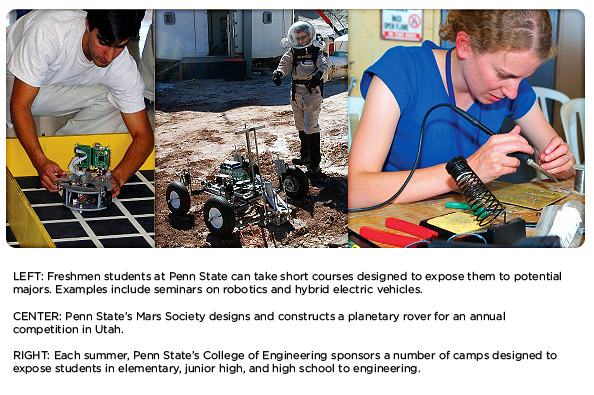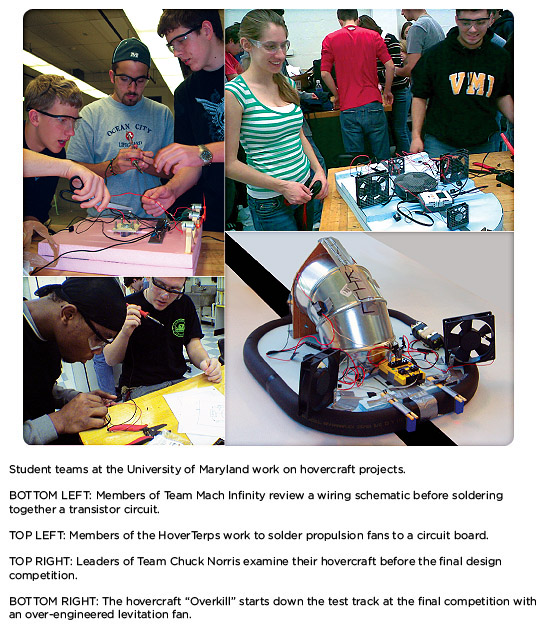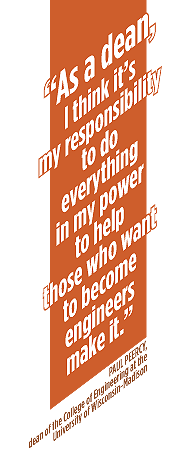Staying on Track
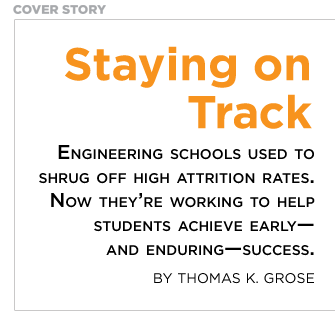
For a number of Daliana Rodriguez’s classmates, first-year engineering presented such “a dramatic change of culture” that they couldn’t cope, she recalls. Jolted by the rigorous lineup of science and mathematics courses, they fled to less demanding disciplines.
In the old sink-or-swim days of engineering education, departments didn’t even try to hold onto such students. The first two years of engineering were loaded with so-called gatekeeper courses—math, physics and chemistry. Flunk one and you were out the door. Perhaps as many as half of freshmen were expected to fail—and good riddance.
But with America struggling to produce a more diverse engineering workforce, schools are abandoning this elitist approach. Now, colleges and universities are redesigning their courses and adding new extracurricular programs and extra-help sessions in an effort not only to attract more engineering students, but to retain them until graduation.
Rodriguez, an industrial engineering major at the University of Puerto Rico, Mayaguez, is a case in point. By the start of her first year, she knew what to expect in engineering, thanks to a two-week summer course offered by the university at which students tackled engineering projects; hers was to design and build a small toy car. The experience at “camp” reinforced Rodriguez’s belief that she was heading in the right direction. She thoroughly enjoyed freshman year. “I had no second thoughts,” she says. It may just be coincidence, but she doesn’t know of anyone attending the camp who later dropped out.
Retention is a serious problem for engineering schools. About a third of students who start college as engineering majors switch to other fields before graduation, according to the 2005 National Academies’ report, Rising Above the Gathering Storm. While these findings came as no surprise to engineering educators, the report served as a serious warning to the country that its global dominance of the physical sciences is at risk. As Paul Peercy, dean of the College of Engineering at the University of Wisconsin-Madison, states, “This country is not educating enough engineers,” and losing so many potential engineers in the first years of college is a huge waste of talent. “We can no longer afford to use physics as a weed-out course,” Peercy says.
Madison is among a growing number of schools working to staunch those losses. But it is no easy chore.
One reason is that Engineering will never be a cakewalk. Freshman and sophomore engineering schedules are still packed with calculus, chemistry and physics. And these courses are no less demanding than before. Thus, many potential engineers—like Rodriguez’s former classmates—still find themselves hitting a brick wall. Why? Some are unprepared. “Not all students have had an opportunity to take advanced placement courses in high school,” explains Renata Engel, associate dean for undergraduate studies at Pennsylvania State University’s College of Engineering. Others take advanced math as early as the 10th or 11th grade, so by the time they get to university, “they’re rusty,” says Peercy. Rarely are students incapable of doing the work. It’s not easy to get into an engineering college; many students come with strong SAT scores and high school grades. So most are up to the task; they may just need some help. Too often in the past, however, assistance was not forthcoming.
Misunderstandings also play a role in schools’ difficulty in keeping engineering students. Many incoming students “have a wrong perception about engineering,” says Lueny Morell, director of university relations/Latin America for Hewlett Packard and a former professor of engineering at Mayaguez. They don’t know what engineers are or what they do. Some of them decide it’s not for them, once they come face to face with the discipline.
William Fourney, associate dean of the A. James Clark School of Engineering at the University of Maryland, suggests that inferior teaching of freshman and sophomore courses has discouraged students: “These courses are not always taught by the best instructors—far too much of that occurs.”
The fact that students have to wait to do any actual engineering has contributed to driving them away. Given the need to stress the mathematical and scientific foundations of engineering, actual engineering courses are often squeezed out in the first two years. And math and science are seldom taught in ways that demonstrate how they feed into engineering. Students already confused by what engineering is aren’t helped by this approach, while those who know what they’re getting into find themselves wondering when the fun will start. “They’re anxious to get into engineering, away from the types of things they studied in high school, to see how it all connects,” says Penn State’s Engel. “They didn’t see engineering as sitting around solving calculus problems.”
Introduction of hands-on projects at early levels not only doesn’t jeopardize standards, it makes them more rigorous, Engel argues. “We’re seeing students invest the time into these projects because they are able to have their ideas and creativity be part of the solution, and it is fun and rewarding to see one’s own ideas come to life.”
As schools attempt to make first-year classes more hands-on for students, some faculty worry that too many modifications could lead to a diluting of basic engineering know-how. “Older faculty are worried about the fundamentals,” says Joseph Rose, a professor of mechanical engineering at Penn State, who has been teaching for more than 35 years. When Penn State added hands-on projects to a Strength of Materials class—which had not used projects before—Rose asked Engel if she was sure the projects, and the content she was removing to make room for them, would leave students prepared for later classes. Specifically, he worried about how they would fare in a subsequent course based on a computer simulation program.
Students can run the program and get an answer, Rose says, but “the danger is, they don’t know why it worked” unless they understand the math fundamentals behind it. Engel took Rose’s concerns into account when the course was overhauled.
“There will always be faculty resistance to any changes,” Peercy says, adding that at Madison, the faculty eventually supported changes made, but only after some “robust debate.”
What follows is a look at how four different engineering schools are working to keep more entry-level students on track and enrolled. Some programs have already had clear successes; others are too new to judge. All are works in progress.
PENNSYLVANIA STATE UNIVERSITY
Penn State focuses on ensuring that new students get that important first taste of engineering in Year One. It created Introduction to Engineering Design, which uses design projects submitted by industry. For example, Armstrong Flooring asked students in one class to come up with examples of what features they think the ceilings of the future will include. Students work in teams, and the content includes solid modeling, graphical communication and computer-assisted-design laboratory work. Engel says the design course is also a good complement to the mathematics and science courses the students must take.
Penn State also overhauled its first-year calculus course. It’s now called Calculus with Engineering Applications—a title that pretty much sums it up. The course, taught by math professors, includes several sections with obvious engineering uses. This not only makes for more subject clarity, Engel says, but is a way to link the hard math of calculus to the discipline by placing it into an engineering context. Beyond problem-solving, the course also emphasizes technical writing and oral presentations. It’s taught in smaller classes, enabling more interaction between students and instructors. That’s a far cry from the calculus classes of 20 years ago, which were largely taught in large lecture halls, she says.
First-year students also get to grapple with actual engineering in a fun way in a one-credit seminar each is required to take. There are more than 50 seminars to choose from. Each is a creation of the instructor, often based on a topic of great interest to him or her. “It’s the rapid deployment of new and great ideas,” Engel says, “and the faculty’s passion is exciting.” Topics include Design for Failure, Ethics of Star Trek, Engineering in Science Fiction and Toy FUNdamentals. The seminars also give freshmen a chance to work with senior faculty they might not otherwise meet until their junior year.
Penn State has also instituted a mid-semester feedback system during the fall and spring terms of the first year. Instructors issue performance ratings on all students. Students rated unsatisfactory are given help with course content, time-management or both. The school now hopes to push up the time frame for early intervention. “There may be opportunities to start earlier; we’re looking to catch earlier indicators,” Engel says. One such sign may come with quizzes given in the first few weeks.
Penn State’s other efforts include residence halls that cater to engineering students to make it easier for them to study and socialize with one another, and a pre-enrollment summer program with preparatory courses in calculus, chemistry and physics. There are also some outside-the-classroom projects open to students from first year to fourth: the Aerospace Engineering Department’s project has students design and build a sailplane; the Society of Automotive Engineers sponsors a race-car project; and those joining the Mars Society work on a Martian rover.
“It’s really about exposing students to engineering early on,” Engel says. Penn State’s retention efforts have been in place for several years, and they seem to be working, based on student feedback. All frosh students at Penn State come in as generalists and most don’t declare a major until after their second year. Some students drift away from engineering but continue in science. Of those who do stay with engineering, 90 to 95 percent go on to get degrees.
UNIVERSITY OF MARYLAND
Maryland, Fourney estimates, probably loses about 25 percent of its freshman engineering cohort by the end of four years. So compared to the national average, it’s already ahead of the retention game. But the school felt it could do better. So it inaugurated what it calls Keystone, a program to help keep students in the program. Now in its second year, Keystone focuses on improving teaching at the early stages. Poor teaching, Fourney says, is a good way to lose promising students. “They get turned off to what engineering is all about.”
Some of the best professors either don’t want to teach at the intro level, or are more interested in research, he says. So the school came up with a new title: Keystone Professor of Fundamentals. And so far, it’s conferred the title upon 10 percent of the faculty, with a goal of selecting 20 percent. Each gets a 2 percent pay increase and a stipend of $2,500 to spend on improving their teaching abilities. “Though it’s nice to know that you can be rewarded for good teaching, no one goes into this for the money,” Fourney says. Getting named as a Keystone Professor is a highly selective process, and this year only half the applicants were awarded the title.
Maryland also successfully encouraged the departments of math, physics and chemistry–since their classes dominate the first two years of engineering–to use better qualified faculty to teach freshman engineering students. There’s no point in improving the quality of engineering teaching if math and science instruction remains poor, he says. The school is also trying to make the teaching of those subjects more relevant to engineering. The efforts to improve teaching are paying off, says Mitchell Forman, a 19-year-old junior. “I’ve liked it a lot,” he says. “They bring in a lot of high-quality professors.” And, Forman adds, Maryland is making it clearer to students from the start how the calculus, physics and chemistry they’re being taught will be applied in engineering.
All classes are now taught in small sections—no more lecture halls. Maryland has also instituted an engineering design course in the first year that lets freshmen get their hands dirty early on. In it, teams of students have to design and build a hovercraft that’s roughly two-foot in diameter and can autonomously fly around a course that includes four right-hand turns. To prepare them for the task, students are given week-long lessons in several basic areas, including fluid mechanics, basic electronic circuits, sensors and controls, and E-pro. “The success rate is small,” Fourney says—somewhere between 10 and 20 percent. But a student needn’t build a successful craft to earn a good grade. Clearly, another key lesson of engineering is that failure is a learning experience. On average, most students pass the course in the mid-B range.
The Keystone program also includes a study center that meets three nights a week. It encourages group study, and groups are led by grad students and teaching fellows. “It’s a place where students can go to get help with homework in engineering or math or science,” Fourney explains.
The attitude that engineering schools should be bastions of indifference to student needs, places where students who sink for lack of help are never missed, is changing. And it’s about time, Fourney says: That kind of thinking not only keeps potentially valuable engineers from the profession, it threatens the country’s well-being. “We lose if we give students the impression we don’t care.”
UNIVERSITY of PUERTO RICO, MAYAGUEZ
Mayaguez has long been recognized for its successful efforts to bring more women into engineering. Nearly 40 percent of its engineering graduates are women, which is about double the national rate. But it’s also had success in ensuring that it retains the lion’s share of students who enroll in engineering: around 75 percent of its first-year students finish the program. Some of that success is the result of a NSF-funded program—the Puerto Rico Louis Stokes Alliance for Minority Participation—begun 16 years ago and aimed at increasing the number of minority and low-income students earning degrees in science, technology, engineering and mathematics.
UPR spearheads the program, though it includes all major universities in the country. As a result of that effort, engineering enrollments at the school have jumped 44 percent and the number of degrees awarded has skyrocketed 84 percent.
Part of the payoff comes from reaching out to high school students well before they enroll in college. The university goes to the schools and talks to elementary and high school students, saying to them, “We dare you study engineering,” explains Sonia Bartolomei, associate dean of academic affairs at Mayaguez’s College of Engineering. In Puerto Rico, most students are required to take math only up to 10th grade, after which it becomes an elective. So, “We tell them to take pre-calculus in high school, so they come here better prepared.” Mayaguez also uses summer camps to whip up enthusiasm. Students at the camps are kept busy with a variety of engineering-oriented activities. For example, students are asked to devise a way to package an egg so it can be dropped from a second-story window without breaking. “It’s fun and it forces kids to think of ways to solve problems using existing technology,” says Manuel Gomez, director of the Resource Center for Science and Engineering, which is based at UPR. And, of course, that’s what engineering is all about–in an eggshell. The camps also let students investigate several engineering disciplines in one setting. The camp experience not only convinced Daliana Rodriguez she wanted to study engineering instead of business but also helped her opt for industrial engineering over mechanical or computer engineering.
Gatekeeper courses were also revamped. Part of that effort involved faculty training and getting instructors to better understand the pedagogy of teaching. Teachers were encouraged to use more active-learning techniques. One physics teacher made his course more hands-on by integrating his classroom and lab sessions. The school also made greater use of grad students to mentor and tutor freshmen and sophomores. Additionally, UPR introduced undergraduate research into the curriculum, using grant money to give students $450 stipends.
Extracurricular activities were also stressed. “It helps having students do more than the bare minimum; it gets them motivated by science and engineering,” Morell says. For example, 20 percent of the school’s engineering undergraduates are involved in a co-op program that lets them sample life in industry, well ahead of graduation.
Students are also encouraged to join the student chapters of professional engineering groups. Rodriguez joined the Society of Hispanic Professional Engineers, which helped her meet and learn from like-minded students. Francis Maldonado, 21, a computer engineering major in his fourth year, joined the IEEE, formerly the Institute of Electrical and Electronics Engineers, which gave him access to useful seminars and workshops. It also helped him snag two summer internships at Microsoft. Maldonado says students also like career fairs, organized by the school’s job-placement office. “They help students see what careers will be available to them once they graduate. That keeps interest going.”
UNIVERSITY of WISCONSIN-MADISON
When Peercy became dean the College of Engineering at Madison in 1999, high on his priority list was tackling the problem of retention. Back then, less than half of the freshmen completed the program. Now, 65 percent make it through. Like Penn State, Wisconsin’s first-years come in undeclared, and remain in that status until they’ve compiled 58 credits, usually in the second year. Also like Penn State, for those students who do declare, nearly 95 percent go on to earn a sheepskin.
One of Peercy’s first efforts was scheduling free-tutoring evenings during the freshman year. Only 425 students took advantage of the initial round, but 750 enrolled in the second, 950 in the third “and now it’s really taken off.” In the Fall 2007 semester, the school provided 5,700 tutoring hours. “It’s changed the culture,” Peercy reports. At first, students would ask those attending why they needed help. “Now it’s, ‘Where were you last night? It’s a lot easier if you do the tutoring.’” With money from a private donor, the engineering school also built a student learning center.
“It’s a very welcoming place, with food and beverages,” the dean says.
Wisconsin also saw the need to inject a more hands-on engineering experience in the first year, coming up with an Introduction to Engineering course that gives students client-centered design projects. It’s team-based, as well, and includes a sampling of all the engineering disciplines while introducing students to computer tools and laboratory techniques. Part of the idea, Peercy says, is to give freshman “a flavor of” engineering classes to come.
And this year the school is piloting a second introductory course, Introduction to Society’s Engineering: Grand Challenges. Students pick a mini-project to work on, and there are many to choose from. Each focuses on solving problems or meeting challenges facing society: food safety, pollution, security, climate change, pandemics—even space travel. Teamwork and global thinking are stressed in these classes because, as Peercy says, the days of an engineer laboring solo in a lab on products that were mainly sold locally or regionally are long gone.
Beyond the classroom, Madison is encouraging project-based student organizations that are open to freshmen. There are 57 now, up from 32 eight years ago. Club projects include working on zero-emission cars or clean-air snowmobiles. Another popular student group is involved in the annual concrete canoe race. That’s a national event pitting teams of students who design and build lightweight canoes using high-tech concrete.
Peercy admits that some freshmen will simply decide engineering is not their calling. But he doesn’t want to lose the many talented potential engineers who, despite stumbling at the starting gate, want to continue into the profession. “As a dean, I think it’s my responsibility to do everything in my power to help those who want to become engineers make it.”
Thomas K. Grose is a freelance writer based in London.
Category: Cover Story
